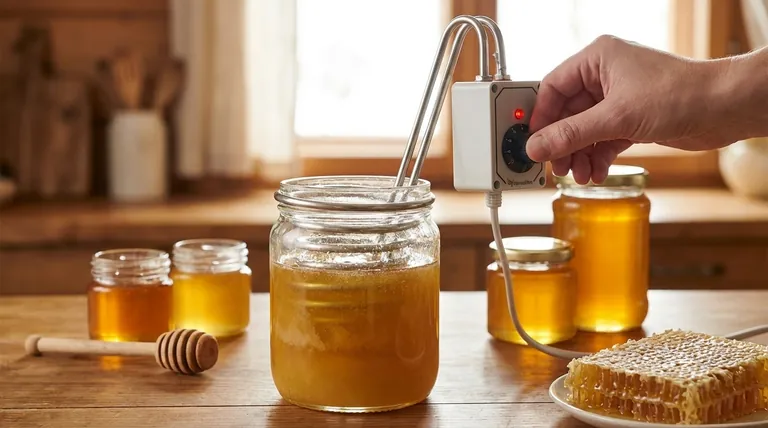To put it simply, heating honey slowly and evenly is crucial for preserving its unique nutritional and enzymatic profile. Rapid or excessive heat effectively "cooks" the honey, destroying the delicate compounds that make it a beneficial food and altering its natural flavor and aroma. The goal is to gently return it to a liquid state, not to fundamentally change its composition.
The core issue is that heat is a destructive force. While necessary to manage honey's viscosity and reverse crystallization, applying it too quickly or at too high a temperature permanently degrades its quality, turning a complex, natural product into little more than a simple sugar syrup.

The Delicate Chemistry of Raw Honey
To understand the impact of heat, you must first appreciate what raw honey contains. It is far more than just a sweetener.
A Complex Profile of Beneficial Compounds
Raw honey contains a host of enzymes, such as diastase and invertase, which are introduced by bees and play a role in honey's stability and unique properties. It is also rich in antioxidants, vitamins, and minerals.
These compounds are the primary reason many people choose honey over other sweeteners. They are, however, extremely sensitive to heat.
The Problem with High Temperatures
Most of the beneficial enzymes in honey are proteins. When exposed to high temperatures—generally anything above 110°F (43°C)—these proteins begin to denature.
Denaturing means they lose their specific three-dimensional structure, rendering them inactive. This process is irreversible.
Why We Heat Honey in the First Place
The most common reason for heating honey is to reverse crystallization. This natural process, where glucose separates from the water in honey, is a sign of high-quality, unprocessed honey but can make it difficult to pour. Gentle heat dissolves these crystals and restores a liquid consistency.
The Consequences of Improper Heating
Applying heat too quickly or unevenly creates "hot spots" that cause significant damage, even if the average temperature seems low.
Nutritional Degradation
The most immediate casualty of excess heat is the enzymatic content. This loss diminishes honey's unique digestive and antibacterial properties. Antioxidants are also vulnerable, reducing the overall health benefits.
Flavor and Aroma Alteration
Honey's flavor is derived from the specific nectar sources visited by the bees. These delicate floral and aromatic compounds are volatile and are easily destroyed or "cooked off" by high heat.
The result is a loss of nuance and a more generic, often caramelized or even slightly burnt, flavor profile.
Formation of HMF
When honey is heated, a compound called Hydroxymethylfurfural (HMF) forms. While not considered harmful in the small amounts found in food, HMF level is a key indicator used in the industry to determine if honey has been overheated or is old.
High levels of HMF are a definitive sign of heat damage and reduced quality. Microwaving honey, for instance, is notorious for causing HMF levels to spike dramatically.
Making the Right Choice for Your Honey
The correct way to heat honey is always gently and indirectly. The best method is to place the honey container in a warm water bath, ensuring the water temperature remains low and stable. Never heat honey directly on a stove or in a microwave.
- If your primary focus is preserving maximum health benefits: Use a warm water bath and keep the temperature below 104°F (40°C), even if it takes longer to liquefy.
- If your primary focus is simply liquefying crystallized honey for use: A warm water bath is still ideal, but slight variations in temperature are less critical if you are not consuming it for its enzymatic properties.
- If you are a beekeeper processing honey for bottling: Invest in a temperature-controlled warming cabinet to ensure the entire batch is heated evenly and minimally, preserving quality and market value.
Ultimately, treating honey with care ensures you are getting the full benefit of this remarkable natural product.
Summary Table:
| Heating Method | Impact on Honey Quality | Key Takeaway |
|---|---|---|
| Slow & Even (Water Bath) | Preserves enzymes, antioxidants, and flavor. Minimizes HMF. | Ideal for maintaining quality and value. |
| Rapid/Uneven (Microwave, Stove) | Destroys beneficial compounds, alters flavor, increases HMF. | Damaging; reduces honey to simple syrup. |
| Temperature-Controlled Cabinet | Ensures uniform, minimal heating for entire batches. | Best for commercial beekeepers and distributors. |
For commercial apiaries and distributors, honey quality is your bottom line.
Preserving the delicate enzymes, flavor, and market value of your honey starts with the right equipment. HONESTBEE supplies professional, temperature-controlled honey warming cabinets and essential beekeeping supplies designed for wholesale operations.
Ensure your entire batch is heated evenly and minimally to protect your product's quality and maximize its value. Contact our experts today to find the right solution for your commercial needs.
Get a Professional Quote & Protect Your Honey's Quality
Visual Guide

Related Products
- Professional Thermostatic Conical Honey Melter
- 10L Stainless Steel Electric Honey Press Machine
- 8-Frame Electric Self-Reversing Honey Extractor Spinner for Commercial Honey Extraction Equipment
- HONESTBEE 3-Frame Manual Acrylic Honey Extractor
- Honey Concentrating Vacuum Heating Thickening Machine Dehumidifier for Honey
People Also Ask
- Is it safe to heat crystallized honey? Restore Your Honey's Liquid State Safely
- Why is heating honey sometimes necessary? The Essential Guide to Processing & Quality
- What equipment is commonly used for heating and processing honey? Essential Tools for Every Beekeeper
- What is melter honey used for? A Low-Cost Ingredient for Bakers and Brewers
- At what temperature does honey flow? Preserve Quality with the Perfect 95°F Sweet Spot



















